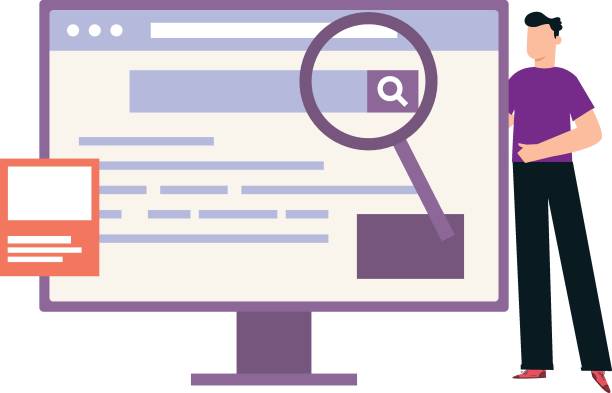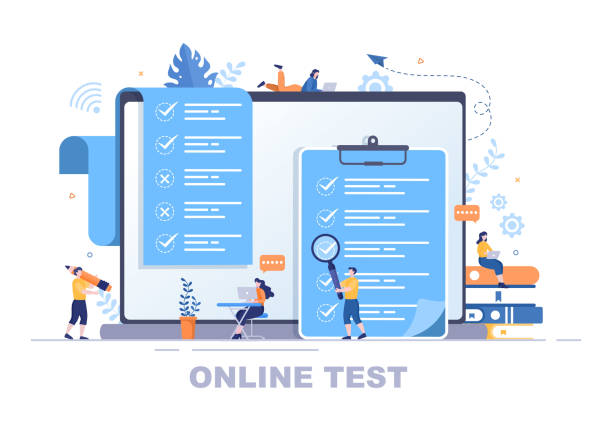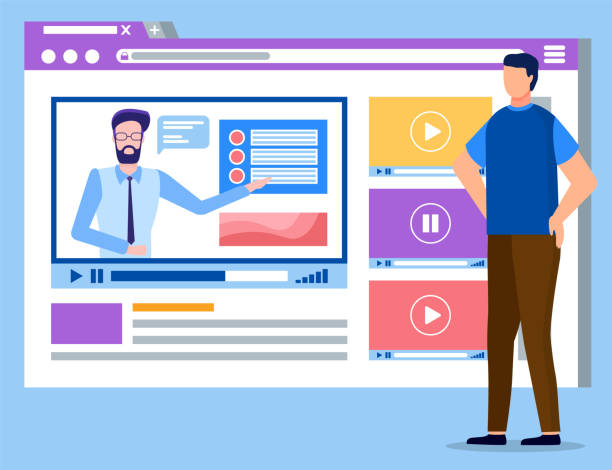An Introduction to the Importance of Multilingual Website Design in the Digital Age

In today’s world, where geographical boundaries have faded in the digital space, #Global_Reach to audiences is of vital importance.
A significant portion of internet users worldwide speak languages other than English.
Ignoring this vast population means losing countless opportunities for your business’s growth and development.
This is where the concept of multilingual website design comes in.
A multilingual website creates a communication bridge between your business and international audiences, removes language barriers, and provides easy access to your information for people with different languages.
This approach not only significantly expands your #Target_Market, but also greatly helps strengthen #Brand_Credibility and increase #User_Trust on a global scale.
The purpose of this #Educational and #Explanatory article is to comprehensively examine various aspects of multilingual website design to assist you on the path to globalizing your online presence.
By correctly understanding the existing needs and solutions, you can build a website that is not only technically powerful but also culturally connects with your global audience.
Did you know that poor online store design can drive away up to 70% of your potential customers? Rasaweb transforms your sales with professional and user-friendly e-commerce website design.
✅ Significant increase in sales and revenue
✅ Full optimization for search engines and mobile
⚡ [Get free consultation from Rasaweb]
Examining the Challenges and Advantages of Multilingual Website Design

Implementing a multilingual website, although accompanied by numerous advantages, also has its specific challenges that need to be carefully examined.
Among the main advantages of multilingual website design is the expansion of the target audience.
By providing content in different languages, you will be able to reach new markets and significantly increase your customer base.
This, in turn, leads to improved SEO and higher rankings in local search engines.
Additionally, a multilingual website increases your brand credibility and provides a deeper understanding of international customers, which ultimately leads to increased conversion rates and greater revenue.
However, there are also challenges along this path.
Translation accuracy is one of the most important of these; machine translations may lack cultural nuances and specific terminology, which can harm your credibility.
Technical complexities in managing URLs, hosting, and databases for different languages are other obstacles.
Ongoing content management and updating it across all languages also require resources and careful planning.
Ignoring cultural differences in user interface design and content can disrupt the user experience.
This #Analytical section helps you look at multilingual website design with a broader perspective and find effective strategies to overcome these challenges.
Technical Approaches to Implementing a Multilingual Website

Choosing the right technical structure for multilingual website design is one of the most vital decisions in the initial stages of a project.
This choice will directly impact your SEO, user experience, and ease of website management.
Generally, there are four main approaches to implementing multilingual websites, each with its own advantages and disadvantages.
The first approach is to use separate country code top-level domains (ccTLDs), such as example.de for Germany or example.fr for France.
This method performs very strongly for local SEO and helps search engines accurately determine your site’s geographical location, but managing and maintaining multiple domains can be complex and costly.
The second approach is to use subdomains, such as de.example.com or fr.example.com.
This method is slightly simpler than separate domains and still provides good geo-targeting capabilities.
The third and most common method is to use subdirectories, such as example.com/de/ or example.com/fr/.
This method is very popular in terms of management and SEO, as all content is placed under a single main domain, and the main domain’s authority is passed to all languages.
The last approach is to use URL parameters, such as example.com?lang=de.
This method is the least recommended for SEO, as it is often not well-indexed by search engines and is considered duplicate content.
Choosing the correct structure for multilingual website design requires a #Specialized analysis of your business goals, budget, and technical resources.
This choice will impact all subsequent aspects, including SEO optimization and user experience.
| Technical Approach | Advantages | Disadvantages | SEO Recommendation |
|---|---|---|---|
| Country-code Top-Level Domains (ccTLDs) | Best for geographical targeting, complete language separation | High cost and complexity, requires separate domain authority | Very Good |
| Subdomains | Good geographical targeting capability, relatively simpler management | Requires separate domain authority (to some extent) | Good |
| Subdirectories | Easiest management, SEO power from main domain | Less precise geographical targeting (requires hreflang) | Excellent (Most Common) |
| URL Parameters | Simplest in terms of initial technical implementation | Weakest SEO, potential duplicate content issues | Poor |
SEO Optimization for Multilingual Websites

Search Engine Optimization (SEO) for multilingual sites is of particular importance, as it ensures that your content is correctly indexed by search engines and displayed to the right audience in different languages.
One of the most important tools in this regard is the correct use of hreflang tags.
These tags inform search engines (like Google) that pages with similar content exist but in different languages, and they prevent duplicate content.
Proper hreflang implementation has its complexities and requires high accuracy in pointing to the correct URLs for each language and region.
In addition to hreflang, geo-targeting in Google Search Console also plays an important role.
This tool allows you to specify your website’s default language and target country.
Keyword research in each target language is also crucial.
Direct translation of keywords is often not enough; instead, you should research and select keywords based on common terms and phrases in each language and culture, in a localized manner.
Unique and high-quality content for each language is crucial not only for SEO but also for user experience.
Avoid machine translations that lead to a drop in quality.
Site loading speed and responsiveness across all languages must also be considered.
By observing these #Specialized and #Guidance tips, you can ensure that your multilingual website design is not only beautiful and user-friendly but also well-visible in search engines.
Are you frustrated by losing customers due to your e-commerce site’s outdated appearance or slow speed? Rasaweb’s expert team solves these problems with professional e-commerce website design!
✅ Increase customer trust and your brand’s credibility
✅ Stunning speed and excellent user experience
Get a free consultation with Rasaweb right now ⚡
Content Management and Translation in Multilingual Websites

The success of a multilingual website design is directly dependent on the quality and management of its translated content.
Simply translating texts word-for-word is not enough; rather, content must be localized, meaning it must be adapted to the culture, terminology, and even the humor and values of the audience for each language.
For this purpose, the use of native translators specialized in your field of activity is highly recommended.
They not only know the language but are also aware of the cultural nuances and specific terms of each region.
In the field of content management, Content Management Systems (CMS) play a key role.
Many popular CMSs like WordPress offer multilingual capabilities through powerful plugins (such as WPML or Polylang).
These plugins allow you to manage different versions of a page or post in various languages, translate menus, and even handle products in multilingual online stores.
Establishing a regular workflow for content translation and updates is also of high importance.
This includes defining responsibilities, using translation memory tools for increased speed and consistency, and review and quality control processes.
A #Explanatory and #Guidance-driven content management strategy ensures that all language versions of your website are always up-to-date, accurate, and tailored to the needs of their respective audiences.
Do not forget that engaging and attractive content can captivate an audience in any language, provided it is properly localized.
User Experience (UX) in Multilingual Website Design

User Experience (UX) in multilingual website design goes beyond mere text translation; it means providing a seamless and comfortable experience for the user, regardless of their language and cultural background.
The first and most important element is the placement of the language switcher in an accessible and prominent location.
This switcher should be easy to find (usually in the site’s header or footer) and display language names (not country flags, which can be ambiguous).
Cultural considerations are an inseparable part of UX in multilingual design.
Colors, images, icons, date and time formats, currency, and even the layout of page elements (such as right-to-left languages like Persian or Arabic) must be carefully adapted for each region.
What is accepted and attractive in one culture may be inappropriate or confusing in another.
This #Educational and #Guidance helps you not overlook the details.
Furthermore, the design must be responsive and ensure that all language versions are displayed correctly on various devices (mobile, tablet, desktop).
Selected fonts must also support the characters of all target languages.
Error messages, notifications, and forms must also be correctly translated and localized so that the user does not feel confused at any stage.
Multilingual website design will only be successful when user experience is prioritized and every user, regardless of their language, feels comfortable and connected with your website.
Popular Tools and Platforms for Multilingual Website Design

Choosing the right tool and platform is an important step in multilingual website design.
Today, there are various options, each offering its own advantages and features.
For Content Management Systems (CMS) like WordPress, powerful plugins such as WPML (WordPress Multilingual Plugin) and Polylang are available, which provide the ability to translate posts, pages, categories, tags, menus, and even widgets.
These plugins simplify the management of different languages from a central dashboard.
Other CMS platforms like Drupal and Joomla also have strong native multilingual capabilities that reduce the need for external plugins and are suitable for larger and more complex projects.
For projects requiring more flexibility, Headless CMSs like Contentful or Strapi are excellent options.
These systems manage content without worrying about how it’s displayed on the front-end, and they allow for providing content in different languages via API to any platform or application.
Alongside CMSs, Translation Management Systems (TMS) like Smartling and Transifex are very useful for projects with high translation volumes.
These tools automate the translation workflow, help translators and reviewers collaborate more efficiently, and increase translation quality.
Choosing the right tools will help you advance your multilingual website design with greater efficiency and quality.
This #Specialized and #Guidance section helps you choose the best option.
| Tool/Platform | Type | Key Features for Multilingual | Suitable For |
|---|---|---|---|
| WPML (WordPress) | CMS Plugin | Full content translation (post, page, theme, WooCommerce), URL management, Hreflang support | Small to medium WordPress websites |
| Polylang (WordPress) | CMS Plugin | Translates posts, pages, categories, tags, widgets, simpler and lighter than WPML | Small to medium WordPress websites, lower budget |
| Drupal | CMS | Native and strong multilingual capabilities, advanced translation management | Large and complex projects, enterprise websites |
| Contentful | Headless CMS | Content via API, high front-end flexibility, can be delivered to any platform | Development teams with specific front-end needs, mobile applications |
| Smartling / Transifex | Translation Management System (TMS) | Translation workflow automation, Translation Memory (TM), Glossary management | High-volume translation projects, professional translation teams |
Security and Maintenance Tips for Multilingual Websites

The security and maintenance of a multilingual website design are as important as its initial design.
By adding more languages and using multilingual plugins or modules, the website’s complexity increases, which in turn can create new security vulnerabilities.
The first step is regular updates of all website components; including the CMS core, plugins, themes, and any translation tools.
Developers constantly release security patches for discovered vulnerabilities, and failure to update can expose your website to cyberattacks.
Secure and reliable hosting is also a key factor.
A hosting provider with strong firewalls, DDoS protection, and regular backups can protect your data.
Using Content Delivery Networks (CDNs) not only improves site loading speed for users in different geographical regions but can also act as an additional layer of security.
Regular backups of all language versions of your website are crucial.
These backups should be stored in a secure location off the main server to allow for quick data recovery in case of any issues.
Continuous monitoring for broken links, untranslated or incorrect content, and server errors should also be a priority.
Ensuring that all language versions of the website are equally secure and optimized is an integral part of the long-term success of your multilingual website design.
This #Specialized and #Guidance section helps you protect your investment.
Disappointed with your e-commerce site’s low conversion rate? Rasaweb transforms your e-commerce site into a powerful tool for attracting and converting customers!
✅ Significant increase in visitor-to-buyer conversion rate
✅ Unparalleled user experience to boost customer satisfaction and loyalty⚡ Get a free consultation from Rasaweb!
Case Studies and Success Stories in Multilingual Website Design

To better understand the positive impact of multilingual website design, many successful real-world examples can be cited.
Companies that have managed to enter global markets and capture a significant share of them by investing in this area.
One of the best examples is large companies active in the field of e-commerce.
For instance, platforms like Amazon or Alibaba could never have become global giants without offering their websites in multiple languages.
They carefully identified the needs of their users in each region and not only translated but also localized the content to ensure a shopping experience perfectly suited to the culture and language of each audience.
Another example is tourism service providers like Airbnb.
Due to the nature of its business, Airbnb is heavily reliant on international audiences.
By offering its website and application in dozens of languages, they have managed to gain the trust of users worldwide and achieve unprecedented popularity.
This case is a #News and #Entertaining story that demonstrates how a meticulous multilingual website design can lead to exponential growth.
These success stories prove that multilingual website design is a valuable investment that not only leads to increased sales and revenue but also strengthens brand credibility, improves customer relationships, and creates a sustainable competitive advantage in the global market.
The key to success in these cases is going beyond mere translation and focusing on complete user experience localization.
The Future of Multilingual Website Design and Emerging Trends

The digital world is rapidly evolving, and multilingual website design is no exception.
Emerging trends are shaping the future of this field, bringing us #Thought-provoking and #Analytical content.
One of the most important of these trends is the significant advancements in Artificial Intelligence (AI) and Machine Learning in translation.
Although machine translation cannot yet fully replace human translators, AI-powered tools are capable of producing initial translations with higher accuracy and quality, which can significantly increase the speed and efficiency of the translation process.
Another trend that should be considered is optimization for multilingual voice search.
With the increasing use of voice assistants and smart speakers, users are searching more than ever through voice commands.
This requires new strategies in SEO and content so that multilingual websites can answer voice queries in different languages.
Content personalization based on user language, location, and even browsing history will also become increasingly important.
This level of personalization significantly enriches the user experience and establishes a deeper connection with audiences.
Ultimately, focusing on localization beyond translation, which means considering cultural, legal, and even political dimensions in each target market, will be essential for the sustainable success of multilingual website design.
These developments indicate that the future of this field is full of new opportunities for connecting with the world.
Frequently Asked Questions
| Question | Answer |
|---|---|
| What is multilingual website design? | The process of building a website whose content is available to users in more than one language. |
| Why should we make our site multilingual? | To reach a wider global audience, improve user experience for non-native speakers, and increase sales or engagement. |
| What are the methods for implementing a multilingual website? | Using subdomains, subdirectories, or URL parameters, or using different Top-Level Domains (TLDs) for each language. |
| Which method is better for SEO? | Generally, using subdirectories (e.g., example.com/fa/) is recommended for SEO, as they share the main domain’s authority. |
| What is the hreflang tag and what is its use? | The hreflang tag is an HTML attribute that helps search engines understand which version of a page is suitable for a specific language or region. |
| Is machine translation sufficient for multilingual website content? | Usually not. Professional translation and content localization are essential for providing a good user experience and maintaining credibility. |
| What does Localization mean? | The process of adapting the content, design, and functionality of a site to the culture, language, currency, and other specific characteristics of a target region or country. |
| What is the importance of language selection in multilingual website design? | Users should be allowed to easily choose their desired language, usually through a clear button or menu in the site’s header. |
| What are the challenges in multilingual website design? | Managing content in different languages, maintaining consistency in design and user experience, multilingual SEO, and translation and maintenance costs. |
| What features should a suitable Content Management System (CMS) have for a multilingual site? | It should allow for easy management of content in different languages, support multilingual URL structures, and provide relevant translation and localization plugins. |
And other services of Rasaweb Advertising Agency in the field of advertising
Smart Reportage: A dedicated service for online growth based on attractive UI design.
Smart Digital Branding: An innovative service for increasing customer acquisition through custom programming.
Smart Sales Automation: Designed for businesses seeking to analyze customer behavior through SEO-driven content strategy.
Smart UI/UX: Transform sales with the help of marketing automation.
Smart Advertising Campaign: An innovative service for increasing sales through intelligent data analysis.
And over hundreds of other services in internet advertising, advertising consultation, and organizational solutions
Internet Advertising | Advertising Strategy | Advertorial
Resources
Multilingual Website Design Tutorial
Importance of Multilingual Website Design
Building a Multilingual WordPress Website
Guide to Making a Website Multilingual
? Ready to transform your business in the digital world? Rasaweb Afarin Digital Marketing Agency, with expertise in SEO, online advertising, and custom website design, is your reliable partner on the path to growth. For a powerful online presence, contact us today!
📍 Tehran, Mirdamad Street, next to Bank Markazi, Southern Kazeroun Alley, Ramin Alley, No. 6




